| Columns Retired Columns & Blogs |
"Stasis" ........... Code 64 :-) ..........
A full set of measurements of the Threshold T-200 was made in the amplifier's unbalanced mode, with selected measurements made in the balanced mode. Unless otherwise noted, the results presented are for the unbalanced configuration. The sample tested (SN 10926) was different from the sample auditioned by RD. Threshold submitted a second sample for measurement, to expedite the completion of the review by minimizing shipping and customs delays between Santa Fe and RD's abode in the Great White North of Toronto, Canada.
Following the 1/3-power, one-hour preconditioning test, the T-200's heatsinks were very warm, but could be touched comfortably for an indefinite period. The T-200 is noninverting in the unbalanced mode; in its balanced configuration, pin 2 is configured as the positive leg, pin 3 the negative.
The T-200's input impedance measured 49.2k ohms unbalanced, 926 ohms balanced. The latter figure is not a typographical error—the balanced input impedance was under 1k ohms. This probably reveals an attempt to maximize power transfer by closely matching the output impedance of the preamp with the input impedance of the power amp. The only other manufacturer I know of who does this is the Jeff Rowland Design Group, and they provide a switch that allows the user to select a higher balanced input impedance.
I have serious reservations about this design philosophy; suffice it to say that the input of a power amplifier responds to voltage, not power. In any event, only a preamplifier capable of performing properly with this low a load impedance (it can put unusual current demands on a preamp; check with your preamp's manufacturer)—or, alternately, one with a very low output impedance (at least under 100 ohms; better yet, under 20 ohms)—should be used with the balanced inputs of the T-200. For general use, the T-200's unbalanced inputs would be the safer bet.
The output impedance of the T-200 was 0.02 ohms at either 1kHz or 20Hz, increasing to 0.026 ohms at 20kHz. Voltage gain into 8 ohms measured 28dB unbalanced, 26.9dB balanced. DC offset was moderate at 7mV in the left channel, 19.5mV in the right. Signal/noise (unweighted ref. 1W into 8 ohms) measured 89.2dB.
Fig.1 shows the frequency response of the T-200. The results shown are for 1W output into 8 ohms (at 2W into 4 ohms, the results were virtually identical). There's little difference between the balanced and unbalanced modes here. The amplifier's reproduction of a 10kHz squarewave is shown in fig.2. There's only a virtually imperceptible degree of rounding at the leading edge, and a fast risetime. The 1kHz squarewave response was close to perfect, and is not shown.
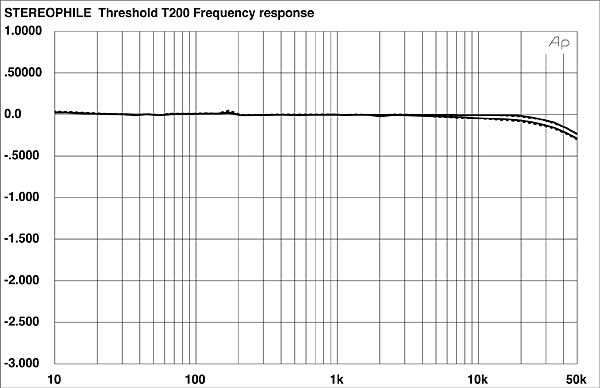
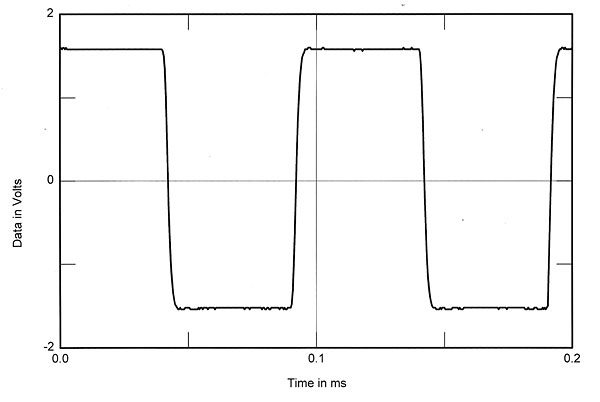
The crosstalk shown in fig.3 indicates nearly identical performance between channels. The increased crosstalk at high frequencies is typical of many two-channel products, and is simply the result of capacitive coupling between the channels.
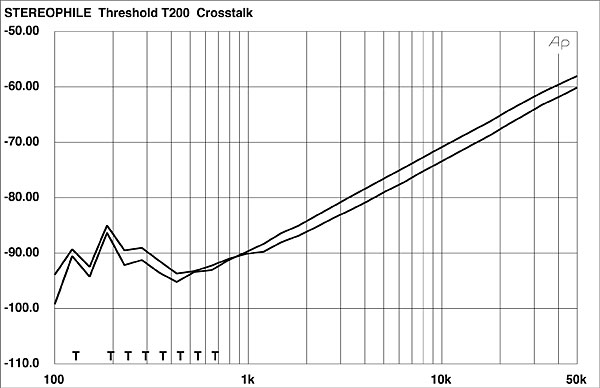
The T-200's THD+noise vs frequency curves are plotted in fig.4, with the balanced result at the top, the unbalanced result at the bottom. Both are extremely low—in fact, the result here is primarily noise. There's a slight rise at the highest frequencies into a 2 ohm load (4W), but it's relatively insignificant. The distortion waveform at a level of 50W into 2 ohms is shown in fig.5—at the levels we normally use to obtain this result, the distortion was impossible to pick out of the noise. The distortion is heavily second-harmonic, with some higher-level harmonics plus noise evident. There was a similar result into higher load impedances (not shown).
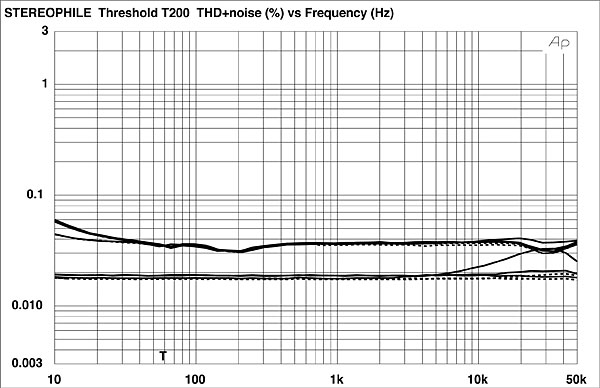
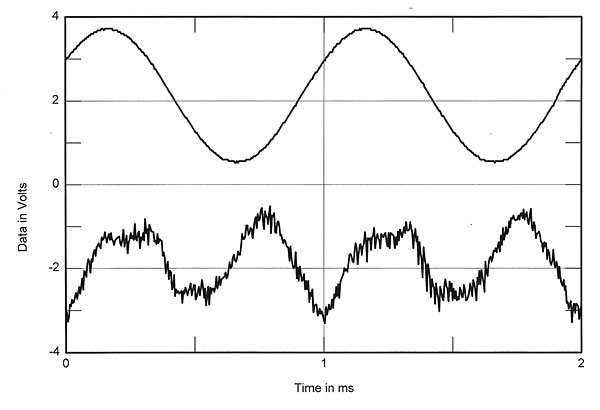
The spectrum of the T-200's output driving 50Hz into 4 ohms at a level of 133W (2/3 rated power with that load) is shown in fig.6. All of the artifacts are under –90dB (0.003%)—a superb result, and one of the best I've ever seen with this test. Surprisingly, the second-harmonic component seen in fig.5 is absent. Fig.7 shows the spectrum of the T-200's output reproducing a combined 19+20kHz signal—the intermodulation products resulting from an input signal consisting of an equal combination of these two frequencies—at 111W RMS into 4 ohms (visible clipping was evident with this signal just above this power level). The largest artifacts here are at 18kHz and 21kHz (under –70dB, or 0.03%). Of the remainder, only the one at 17kHz is marginally higher than –80dB (0.01%). The 19+20kHz spectral response at 61W into 8 ohms indicates even lower intermodulation levels (not shown).
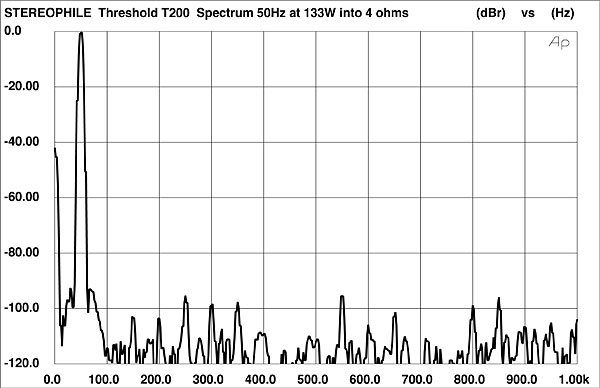
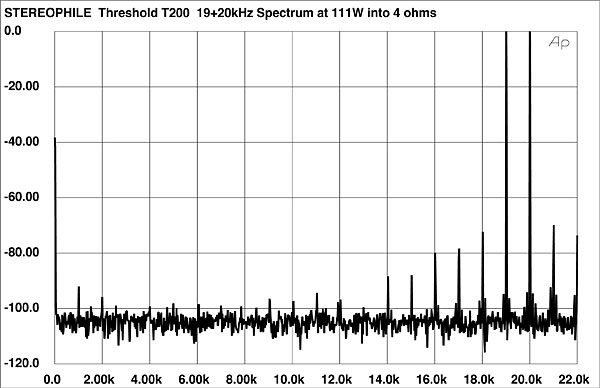
The 1kHz THD+N vs output power curves are shown in fig.8. The power increases substantially as the load impedance decreases, though doesn't quite double with each halving of impedance down to 2 ohms (a rare quality). [Note the discrete increases in distortion level each time the Audio Precision generator increases its output voltage. I don't know what this is due to—perhaps it's the effect of the thermal-bias tracking circuit—but in any case, the distortion level is so low that nothing audible would result.—Ed.] The T-200's discrete-clipping levels (at 1% THD+N) are shown in Table 1.
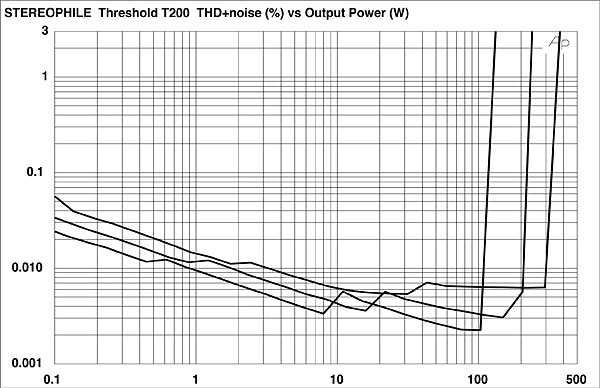
Finally, the THD+N vs output for the T-200 in bridged mode are shown for both 8 ohm and 4 ohm loads in fig.9. As expected, the T-200 puts out considerably more power in the bridged mode, though this mode of operation was not auditioned.
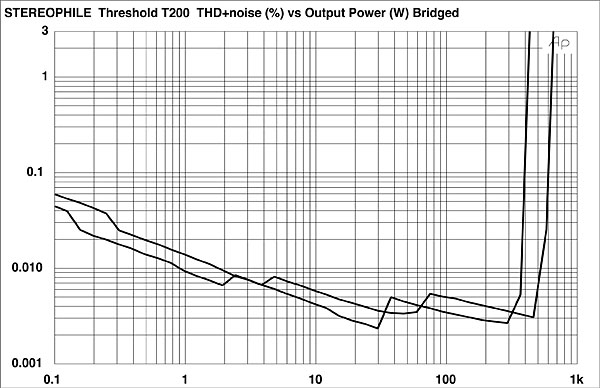
These test-bench results show the Threshold T-200 to be a first-rate amplifier. input impedance: use of the balanced input with the T-200 will require the user to carefully choose his or her preamp if problems are to be avoided.—Thomas J. Norton

"Stasis" ........... Code 64 :-) ..........